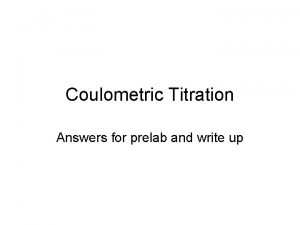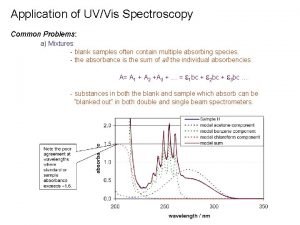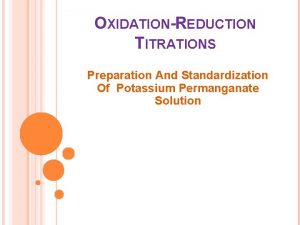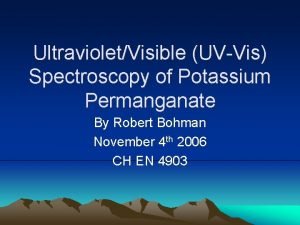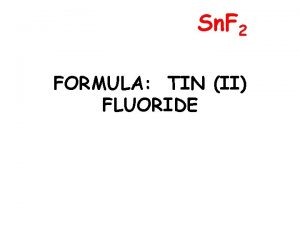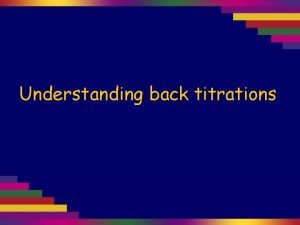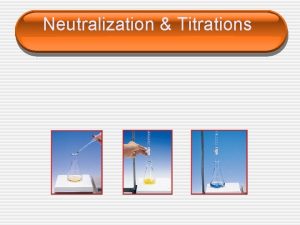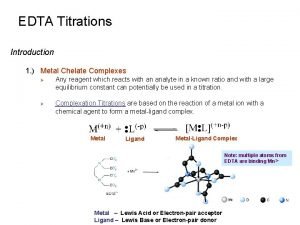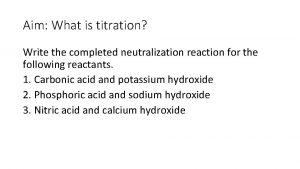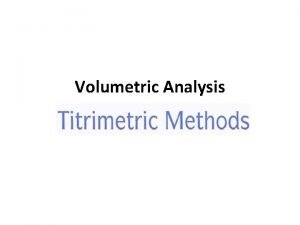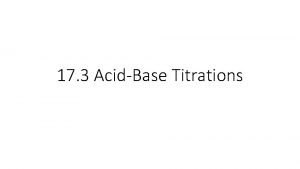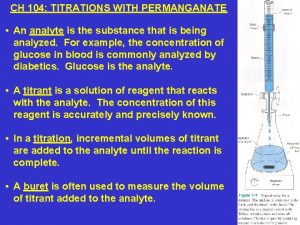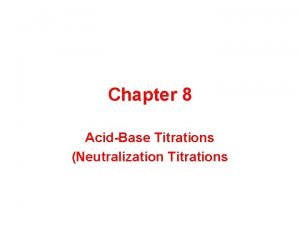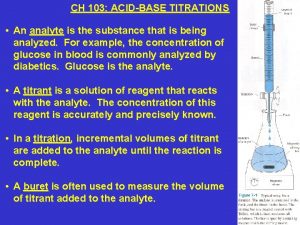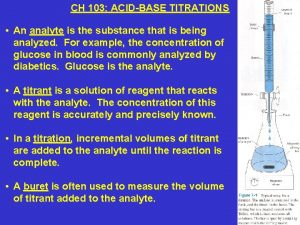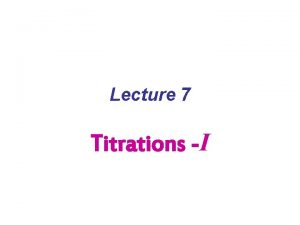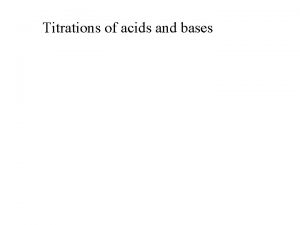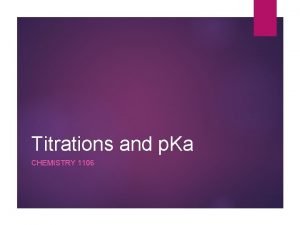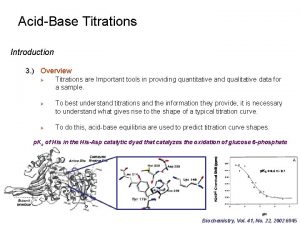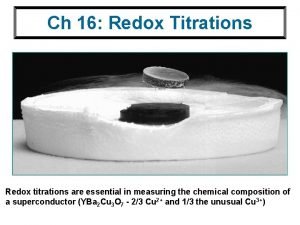CH 104 TITRATIONS WITH PERMANGANATE An analyte is













- Slides: 13

CH 104: TITRATIONS WITH PERMANGANATE • An analyte is the substance that is being analyzed. For example, the concentration of glucose in blood is commonly analyzed by diabetics. Glucose is the analyte. • A titrant is a solution of reagent that reacts with the analyte. The concentration of this reagent is accurately and precisely known. • In a titration, incremental volumes of titrant are added to the analyte until the reaction is complete. • A buret is often used to measure the volume of titrant added to the analyte.

REQUIREMENTS OF A TITRATION 1. The reaction must be stoichiometric. For example, the net ionic equation for the reaction of potassium permanganate (KMn. O 4) and sodium oxalate (Na 2 C 2 O 4) is quantitative. Exactly 2 moles of KMn. O 4 react with exactly 5 moles of Na 2 C 2 O 4. 1. 2 Mn. O 4–(aq)+ 16 H+(aq)+ 5 C 2 O 42–(aq) → 2 Mn 2+(aq)+ 8 H 2 O(l)+ 10 CO 2(g) 2. The reaction should be rapid. 3. The reaction should be specific; that is, there should be no competing reactions. Systematic error caused by interferences must be eliminated or reduced.

REQUIREMENTS OF A TITRATION 4. There should be a marked change when the reaction is complete. For example, this reaction is self-indicating. The titrant (KMn. O 4) is deep purple. The analyte (Na 2 C 2 O 4) and products (Mn 2+, H 2 O, and CO 2) are nearly colorless. The titration is done when the first fraction of a drop of excess Mn. O 4– changes the solution from nearly colorless to a faint and stable pink.

EQUIVALENCE POINT, END POINT, AND INDICATORS • The equivalence point occurs when the volume of titrant added to the analyte is the exact stoichiometric amount that is needed to bring the reaction to completion. • The end point occurs when the indicator changes color. • We want to measure the equivalence point. We actually measure the end point. • Obviously, the faint pink Mn. O 4– end point does not occur at the equivalence point. This end point occurs a fraction of a drop after the equivalence point. This error is small and can be corrected with a blank, or during standardization. • How would you use a blank to correct this error? • The volume of Mn. O 4– used to reach the end point during the titration of distilled water (a blank) is subtracted from all standards and all samples. • How would you standardize to correct this error? • All standards and all samples are titrated to the same end point. We will do this today.

EQUIVALENCE POINT, END POINT, AND INDICATORS Titration using Permanganate as a Self-Indicator • When do you stop adding titrant to the analyte? • At the end point.

STANDARDIZATION • Today we will standardize KMn. O 4 against Na 2 C 2 O 4. 2 Mn. O 4–(aq)+ 16 H+(aq)+ 5 C 2 O 42–(aq) → 2 Mn 2+(aq)+ 8 H 2 O(l)+ 10 CO 2(g) • This is an oxidation-reduction reaction. That is, electrons are transferred from 1 reactant to another reactant. • Oxidation is a loss of an electron or electrons by an atom or group of atoms. • Reduction is a gain of an electron or electrons by an atom or group of atoms.

STANDARDIZATION • Today we will standardize KMn. O 4 against Na 2 C 2 O 4. 2 Mn. O 4–(aq)+ 16 H+(aq)+ 5 C 2 O 42–(aq) → 2 Mn 2+(aq)+ 8 H 2 O(l)+ 10 CO 2(g) • In this reaction, C 2 O 42– is oxidized to CO 2, and Mn. O 4– to reduced to Mn 2+. • What is the Lewis structure for C 2 O 42–? • What is the Lewis structure for CO 2? • Why is the C of CO 2 more oxidized than the C of C 2 O 42–? • The C in CO 2 is in the +4 oxidation state [(1 x +4) + (2 x – 2) = 0]. Each C in C 2 O 42– is in the +3 oxidation state [(2 x +3) + (4 x – 2) = – 2]. Therefore, each C lost 1 electron and was oxidized during this reaction.

STANDARDIZATION • Today we will standardize KMn. O 4 against Na 2 C 2 O 4. 2 Mn. O 4–(aq)+ 16 H+(aq)+ 5 C 2 O 42–(aq) → 2 Mn 2+(aq)+ 8 H 2 O(l)+ 10 CO 2(g) • What is the oxidation state of Mn in Mn. O 4–? • The +7 oxidation state [(1 x +7) + (4 x – 2) = – 1]. • What is the oxidation state of Mn 2+? • The +2 oxidation state [(1 x +2) = +2]. • Why is the Mn of Mn 2+ more reduced than the Mn of Mn. O 4–? • Mn 2+ is in the +2 oxidation state. The Mn of Mn. O 4– is in the +7 oxidation state. Therefore, Mn gained 5 electrons and was reduced during this reaction.

STANDARDIZATION • Na 2 C 2 O 4 is a primary standard. • For example, a solution was made by dissolving 1. 095 g of Na 2 C 2 O 4 in 100. 0 m. L of distilled water. The molar mass of Na 2 C 2 O 4 is 134. 0 g/mol. A 25. 00 m. L sample of this Na 2 C 2 O 4 solution was titrated with 39. 58 m. L of a KMn. O 4 solution to a self-indicating end point. What is the molarity (M) of this KMn. O 4 solution?

REQUIREMENTS OF A PRIMARY STANDARD 1. A primary standard should be 100. 00% pure; although a 0. 01% to 0. 02% impurity is tolerable if it is accurately known. 2. A primary standard should be stable at drying temperatures, and it should be stable indefinitely at room temperature. (A primary standard is always dried before weighing, unless it is a hydrate. ) 3. It should be readily available. 4. It should have a relatively large formula weight. Therefore, a relatively large mass of it will be weighed for titration. This will reduce error. • Explain this last point.

OXIDATION–REDUCTION TITRATION WITH PERMANGANATE • After the KMn. O 4 is standardized, we will measure the Fe(II) content of an unknown salt. Mn. O 4–(aq) + 8 H+(aq) + 5 Fe 2+(aq) → Mn 2+(aq) + 4 H 2 O(l) + 5 Fe 3+(aq) • What is oxidized? • The Fe is oxidized from +2 to +3. • What is reduced? • The Mn is reduced from +7 to +2.

SAFETY • Give at least 1 safety concern for the following procedure. • Using oxidizing agents (KMn. O 4), reducing agents (Na 2 C 2 O 4 and unknown Fe(II) salt), and acids (H 2 SO 4 and H 3 PO 4). • These are irritants. Wear your goggles at all times. Immediately clean all spills. If you do get either of these in your eye, immediately flush with water. • Your laboratory manual has an extensive list of safety procedures. Read and understand this section. • Ask your instructor if you ever have any questions about safety.

SOURCES • Christian, G. D. 1986. Analytical Chemistry, 3 rd ed. New York, NY: John Wiley & Sons, Inc. • Harris, D. C. 1999. Quantitative Chemical Analysis, 5 th ed. New York, NY: W. H. Freeman Company. • Mc. Murry, J. , R. C. Fay. 2004. Chemistry, 4 th ed. Upper Saddle River, NJ: Prentice Hall. • Petrucci, R. H. 1985. General Chemistry Principles and Modern Applications, 4 th ed. New York, NY: Macmillan Publishing Company.
 Titrant vs titrate
Titrant vs titrate Effect of solvent polarity on uv absorption
Effect of solvent polarity on uv absorption How to find molecular formula
How to find molecular formula How to get empirical formula from percentages
How to get empirical formula from percentages Preparation and standardization of potassium permanganate
Preparation and standardization of potassium permanganate Potassium permanganate uv vis spectrum
Potassium permanganate uv vis spectrum Tin 2 fluoride formula
Tin 2 fluoride formula Titration vs back titration
Titration vs back titration Neutralization titrations
Neutralization titrations What is chelate
What is chelate Titration formulas
Titration formulas Types of titrations
Types of titrations Precipitation titration problems with answers
Precipitation titration problems with answers Types of titrations
Types of titrations
